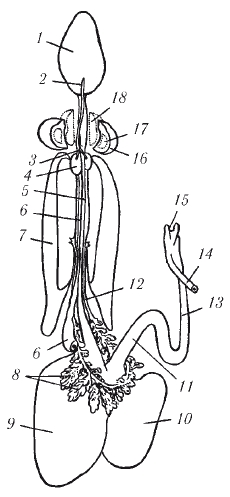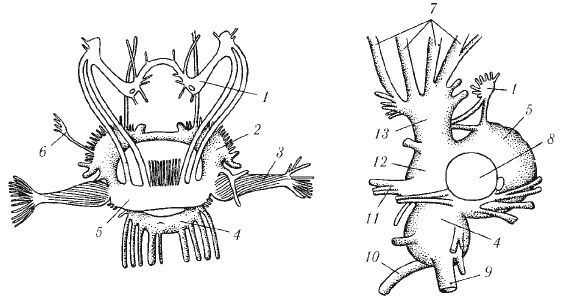The class of the most complexly organized, large, and sometimes very large free-living molluscs.
a brief description of
|
Structure |
The body is bilaterally symmetrical with a sharp division into the head and trunk. The leg is turned into tentacles, or arms. The shell is rudimentary. The torso is dressed on all sides with a mantle |
|
Digestive system |
Mouth, muscular throat. Tongue with radula. Esophagus, muscular stomach. The small intestine ends in powder. Liver |
|
Respiratory system |
|
|
Circulatory system |
The heart consists of one ventricle and two or four atria. The circulatory system is not closed. Blood contains hemocyanin, which makes it blue when exposed to air. |
|
excretorysystem |
Consists of two or four kidneys. The internal opening of the kidneys opens into the pericardium, the external - into the mantle cavity |
|
Nervous system |
The peripharyngeal ganglia are large and form a common peripharyngeal mass, from which two large mantle nerves arise. |
|
sense organs |
Organs of smell. Developed organs of vision |
|
reproductive system |
Cephalopods are dioecious, sometimes with sharp sexual dimorphism. Fertilization is internal, occurs in the mantle cavity of the female |
|
Development |
All development takes place inside the egg shell. |
general characteristics
Structure . Body comprises heads, legs And torso. Head And torso, unlike gastropods, do not have a clear distinction. On the dorsal side of the body mantle forms covers of the body, and on the abdominal - separated from the body mantle cavity. At the place of transition of the body
in the head the mantle cavity has abdominal opening to communicate with the external environment. The mantle cavity contains funnel, which grows to the body (Fig. 1). One end of the funnel opens into the mantle cavity, the other goes out through the abdominal opening. By using mantle muscles the mantle fits snugly to the body, and water is forced outward through the funnel from the mantle cavity. The muscles then relax and the cavity fills up with water again. Due to such rhythmic contractions of the mantle muscles, swimming movements and molluscs move backwards forward. The leg in cephalopods is very much modified: it fit funnel And tentacles. Tentacles form perioral crown.
Rice. 1.Cuttlefish with an open mantle cavity (view from the ventral side): 1 - arms with suckers; 2 - trapping hand; 3 - mouth; 4 - funnel opening; 5 - funnel; 6 - cartilaginous pits of cufflinks; 7 - anal papilla with anus; 8 - renal papillae; 9 - unpaired genital papilla; 10 - gills; 11 - fin; 12 - cut line of the mantle; 13 - unfolded mantle; 14 - cartilaginous tubercles of cufflinks; 15 - mantle stellate ganglion
In lower forms ( boat) - an indefinite number of identical tentacles. In some higher cephalopods ( octopuses) available 8 well-developed large tentacles of the same size. Other's ( cuttlefish, squid) besides this, there is also 2 much longer tentacles with extensions at the ends. The tentacles of higher cephalopods bear numerous large disc-shaped suckers, serving to capture prey or attach to the bottom. The shell is present only in ancient forms. In most cephalopods the shell is rudimentary. The connective tissue layer of the skin contains numerous pigment cells, or chromatophores, with which under the control of the nervous system of the molluscs can change body color. In cephalopods, unlike other molluscs, one can distinguish a special internal skeleton - cartilaginous head capsule, which protects the central nervous system and physiologically corresponds to the skull of vertebrates.
Digestive system
(Fig. 2). Mouth lies in the center of the crown of tentacles. Next comes pharynx with radula. Appear in the throat two thick horny jaws, similar to the beak of a parrot, which are mainly involved in capturing and crushing food. Fall into the throat ducts of two pairs of salivary glands(the couple's secret glands are poisonous).
The pharynx continues into the esophagus, which often forms a goiter, and further into the sac-like stomach. After the stomach comes the small intestine, which ends with the hindgut and anus. Liver ducts enter the stomach
seated with numerous glandular appendages, which are often called the pancreas.

Rice. 2. Digestive system of cuttlefish (from the ventral side): 1 - pharynx; 2 - common salivary duct; 3 - salivary duct; 4 - posterior salivary gland; 5 - esophagus; 6 - head aorta; 7 - liver; 8 - pancreas; 9 - stomach; 10 - blind sac of the stomach; 11 - small intestine; 12 - hepatic duct; 13 - rectum; 14 - ink bag duct; 15 - anus; 16 - head cartilaginous capsule (cut); 17 - cavity of the statocyst capsule; 18 - nerve ring (cut)
Respiratory system. The respiratory organs, like all mollusks, are in the mantle cavity. Gills located symmetrically on the sides of the body. The exchange of water in the mantle cavity is carried out due to the activity mantle muscles And funnels.
Circulatory system. Heart cephalopods are made up of one ventricle And two or four atria. depart from the stomach two large aorta: head(carries blood to the head and tentacles) and splanchnic(supplies blood to the intestines and genitals). Cephalopod blood contains hemocyanin, so in the air turns blue.
excretory system. kidneys represent bags, the front openings of which open near the powder, and internal - in the pericardial part of the coelom. Blind protrusions of the vena cava protrude into the walls of the kidneys - venous appendages which facilitate the removal of metabolic products from the blood. Kidneys, like gills, can be 2 or 4.
Nervous system cephalopods reaches the greatest complexity of the structure compared to other molluscs. ganglia enough great And form a single peripharyngeal nerve mass(Fig. 3).
Sense organs. Olfactory organs located at the base of the gills or under the eyes. organs of vision can be represented by large eye fossae, the cavity of which communicates with the external environment through a small hole, or eyes, in structure resembling the eyes of mammals. The compound eyes of cephalopods have accommodation at the expense approximation or removal of the lens from the retina. Also available adaptations for vision in strong and low light.
Deep-sea cephalopods have special glow organs.
Sexual system. cephalopods separate sexes. In some species, there is sexual dimorphism. Fertilization most often occurs in the mantle cavity of the female, where are formed and egg shells. All development proceeds inside the shells of the egg and without metamorphosis.

Rice. 3. The central nervous system of cephalopods: 1 - buccal ganglion; 2 - pedal ganglion; 3 - optic nerve; 4 - visceral ganglion; 5 - cerebral ganglion; 6 - nerve going to the hood and tentacles; 7 - nerves of the hands; 8 - the place of origin of the optic nerve; 9 - mantle nerve; 10 - nerve going to the insides; 11 - funnel nerve; 12 - infundibular ganglion; 13 - brachial ganglion (12 and 13 - derivatives of the pedal ganglion)
